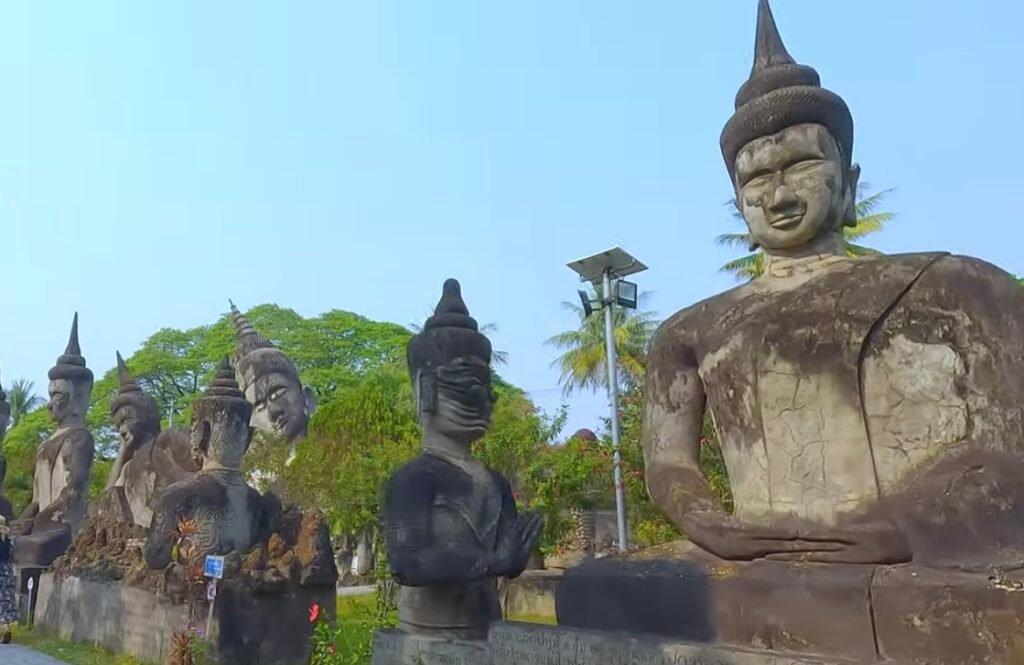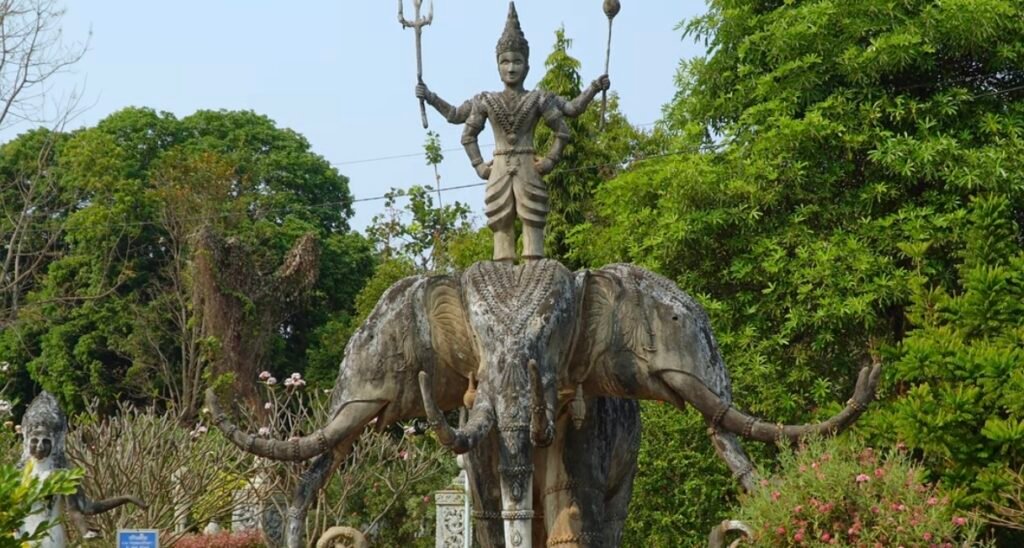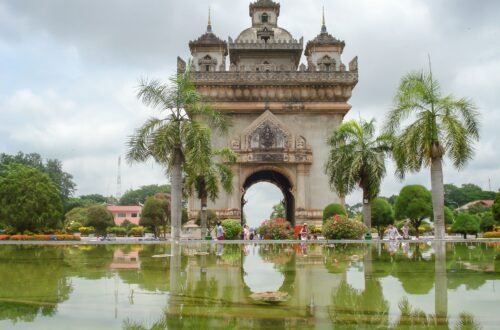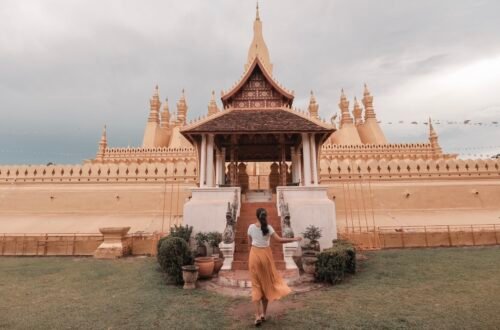
Discovering the Wonders of Buddha Park: A Travel Guide to Laos’ Must-See Attraction


Laos is a beautiful country that is rich in culture and history. It’s a place that offers visitors a unique and unforgettable experience. One of the must-see attractions in Laos is the Buddha Park, also known as Xieng Khuan. This park is a breathtaking sculpture park located in Vientiane, the capital city of Laos. It’s a perfect destination for anyone looking to explore the country’s rich history and culture. The park is a unique blend of Buddhism and Hinduism, and the sculptures are striking and unforgettable. In this travel guide, we’ll take you on a journey to discover the wonders of Buddha Park. We’ll tell you everything you need to know about the park, how to get there, what to expect, and why it’s a must-see attraction when you visit Laos. So, pack your bags and let’s explore the beauty of Buddha Park together!
Introduction to Buddha Park
Buddha Park, also known as Xieng Khuan, is a unique and awe-inspiring attraction located on the banks of the Mekong River in Vientiane, Laos. The park was designed and built by a monk named Bunleua Sulilat in 1958. He was a visionary artist with a passion for Buddhism and Hinduism, and he wanted to create a park that would showcase his beliefs to the world.
The park is home to over 200 statues and sculptures, all of which are intricately designed and crafted. The most famous of these sculptures is the giant reclining Buddha, which measures over 40 meters in length. There are also several other Buddha statues, as well as sculptures of Hindu gods and goddesses.
Visitors to Buddha Park will be mesmerized by the beauty and serenity of the park. The lush green trees and the sound of the Mekong River create a peaceful and tranquil atmosphere that is perfect for meditation and reflection.
Buddha Park is a must-see attraction for anyone visiting Laos. It is a testament to the beauty and complexity of Buddhist and Hindu art, and it provides a unique insight into the beliefs and values of the people of Laos. Whether you are a seasoned traveler or a first-time visitor, a trip to Buddha Park is an experience that you will never forget.
The History Behind Buddha Park
Buddha Park is one of the most fascinating and popular tourist attractions in Laos. The park is filled with over 200 statues and sculptures, including a massive 130-foot-long reclining Buddha. But what is the history behind this incredible park?
The park was designed and created by a famous Buddhist monk and sculpture artist named Bunleua Sulilat. He was born in Laos in 1932 and became a monk at the age of 15. In the 1950s, he moved to Thailand and became interested in sculpture and art. In the 1970s, he moved back to Laos and began work on what would become Buddha Park.
The park was officially opened in 1958 and has since become a popular destination for both tourists and locals alike. The sculptures and statues in the park are inspired by both Buddhist and Hindu mythology and include depictions of gods, demons, and animals.
One of the most interesting aspects of the park is the giant pumpkin-shaped structure in the center. Visitors can climb up through the levels of the structure, each level representing a different stage of Buddhist enlightenment, and at the top, they are rewarded with stunning views of the surrounding area.
In addition to the sculptures and structures, there are also numerous meditation and prayer areas throughout the park, making it a spiritual and peaceful place to visit. The history and meaning behind Buddha Park make it a truly unique and special destination for travelers to Laos.
How to Get to Buddha Park
Getting to Buddha Park is a relatively easy process, and there are a few different options available to travelers. The park is located roughly 25 kilometers south of Vientiane, the capital city of Laos.
One of the most popular ways to get to Buddha Park is by hiring a taxi or tuk-tuk from Vientiane. This is a great option if you’re traveling with a group, as you can negotiate a reasonable price for the ride. Another option is to take a local bus, which departs from the Talat Sao bus station in Vientiane. The bus ride takes about an hour and drops visitors off right outside the park entrance.
If you’re feeling adventurous, you can also rent a motorbike or bicycle in Vientiane and make the journey to Buddha Park on your own. This is a great way to experience the beautiful countryside of Laos and take in the stunning views along the way.
Overall, getting to Buddha Park is a relatively simple process, and visitors have a variety of transportation options to choose from depending on their preferences and budget.
Opening Hours and Admission Prices
Before planning your visit to Buddha Park, it’s important to take note of the park’s opening hours and admission prices. The park is open every day of the week from 8:00 AM to 4:00 PM, with the last admission at 3:30 PM.
As for the admission prices, it’s very affordable. The entrance fee for foreign visitors is 15,000 kip, which is roughly around 2 USD. For local visitors, the fee is only 5,000 kip.
It’s important to note that there are no additional fees for taking pictures or using your camera within the park. However, if you plan to bring a professional camera or take videos, a fee of 10,000 kip will be charged.
It’s highly recommended to arrive at the park early to avoid the crowds and the heat of the day, especially during peak season. Additionally, make sure to bring sunscreen, a hat, and plenty of water as the park is quite large, and you’ll be doing a lot of walking. With this information, you can plan your visit to Buddha Park and have a memorable experience exploring the park’s unique and fascinating statues.
A Tour of the Park’s Main Attractions
Buddha Park is a breathtaking tourist attraction that you will surely enjoy exploring. The park houses over 200 statues and sculptures that range from small to massive in size. Here are some of the park’s main attractions that you shouldn’t miss:
1. The Giant Pumpkin: This massive sculpture is the first thing you’ll see when entering the park. It is also one of the most photographed attractions in Buddha Park. The pumpkin sculpture has three levels, each representing different realms of Buddhist cosmology.
2. The Reclining Buddha: This statue is one of the most popular attractions in the park. It is a 40-meter-long sculpture of a Buddha lying on his side, with a peaceful expression on his face. This sculpture is a must-see, as it is one of the largest reclining Buddha statues in the world.
3. The Hell Realm: This attraction is not for the faint-hearted. It is a sculpture garden that depicts the various punishments that await those who do not follow Buddhist teachings. The sculptures are graphic and may be disturbing to some visitors, but they provide a unique insight into Buddhist beliefs.
4. The Wheel of Life: This sculpture features a large wheel with various images that represent the six realms of existence in Buddhist cosmology. The wheel is set on a pedestal and visitors can walk around it while reflecting on the teachings of Buddhism.
5. The Three-Headed Elephant: This sculpture is a unique depiction of the Hindu deity, Airavata. It is a three-headed elephant, with each head representing a different aspect of the deity. The sculpture is massive and is one of the most impressive in the park.
These are just some of the main attractions that you can explore in Buddha Park. The park has so much to offer, and you can spend hours exploring and admiring the various sculptures and statues.
The Significance of the Statues and Sculptures
The Buddha Park is home to a collection of over 200 statues and sculptures, each with its own unique significance. The park is essentially a representation of Buddhist and Hindu mythology, with each statue symbolizing different deities and characters from these religions.
One of the most prominent figures in the park is the giant reclining Buddha image, which is said to represent the Buddha’s attainment of Nirvana, or ultimate enlightenment. Other notable figures in the park include the four-armed deity of Hinduism, Lord Shiva, and the ten-faced demon king, Ravana. Each statue has a story to tell, and visitors can immerse themselves in the rich religious and cultural history of Laos as they explore the park.
In addition to the statues, the park features intricate carvings and murals, which are equally as significant and visually stunning. The carvings depict various scenes from Buddhist and Hindu mythology, and the murals showcase the intricate skill of the artists who created them.
Overall, the significance of the statues and sculptures in the Buddha Park is what truly sets it apart as a must-see attraction in Laos. Visitors can gain a deeper understanding and appreciation of the country’s religion and culture as they explore the park and its many wonders.
Tips for Visiting Buddha Park
If you’re planning a visit to Laos, Buddha Park before you head off to explore this iconic landmark, it’s important to keep a few things in mind to ensure a smooth and enjoyable trip.
Firstly, make sure to wear comfortable shoes as you’ll be walking around the park for a few hours. It’s also a good idea to bring along some sunscreen and a hat, as the park can get quite hot during the day.
Secondly, it’s important to remember that Buddha Park is a sacred site, so it’s important to be respectful and dress appropriately. Be sure to cover your shoulders and knees and take your shoes off before entering any of the temples or shrines.
Thirdly, if you’re planning on taking photos, it’s important to ask for permission first, especially when taking photos of locals or monks. It’s always best to be respectful and to ask before taking photos of people or sacred objects.
Lastly, if you’re traveling with children, be sure to keep an eye on them at all times, as some of the structures in the park can be steep and dangerous to climb.
By keeping these tips in mind, you’re sure to have an unforgettable visit to Buddha Park, one of the most remarkable landmarks in Laos.
Other Attractions in the Vicinity
While Buddha Park is certainly the main attraction in the area, there are other nearby sites that are worth exploring. One such site is the Wat That Luang Neua, a beautiful temple located just a few miles from the park. This temple is home to a stunning gold-encrusted stupa that is said to contain a relic of the Buddha himself. It’s worth taking the time to explore the temple and marvel at its intricate architecture.
Another nearby attraction is the Lao-Thai Friendship Bridge, which spans the Mekong River and connects Laos to Thailand. The bridge is an impressive feat of engineering and offers stunning views of the surrounding landscape. Visitors can walk or drive across the bridge and explore the border town on the other side.
For those interested in history, the nearby town of Xieng Khuan is home to several important monuments related to the Vietnam War. This includes the Plain of Jars, a series of ancient stone jars that were used for funerary practices during the war. Visitors can also explore the nearby caves, which were used by the local people as shelters during the war.
Overall, there are plenty of other attractions in the vicinity of Buddha Park to explore, making it the perfect destination for a day trip or weekend getaway.
Places to Eat and Drink Nearby
After a day of exploring the wonders of Buddha Park, you might work up quite an appetite. Luckily, there are a few great places to eat and drink in the area.
One of the most popular options is the Sala Cafe, located just outside the park. This charming cafe offers a variety of delicious food and drinks, including traditional Lao dishes and Western options. The outdoor seating area is a lovely spot to relax and take in the beautiful surroundings.
If you’re looking for something a bit more upscale, head to the Sengtawan Riverside Restaurant. This restaurant offers stunning views of the Mekong River and a menu that focuses on fresh seafood and traditional Lao cuisine. Be sure to book a table in advance, as this spot can get quite busy.
For a more laid-back atmosphere, check out the Riverside Bar. Located on the banks of the Mekong River, this bar offers a variety of cocktails and beers, as well as a selection of snacks and small plates. It’s the perfect spot to unwind and watch the sunset after a long day of sightseeing.
No matter what type of cuisine or atmosphere you’re looking for, there are plenty of options near Buddha Park to satisfy your cravings. Just be sure to bring your appetite!
Conclusion and Final Thoughts on Buddha Park.
In conclusion, Buddha Park is a must-see attraction for any traveler visiting Laos. It is a unique and fascinating place that offers a glimpse into the Buddhist and Hindu beliefs and traditions.
The park is full of impressive and intricate sculptures that represent various deities, demons, and characters from Buddhist and Hindu mythology. Walking around the park, visitors will be impressed by the creativity and imagination of the artist, Bunleua Sulilat, who created the sculptures in the 1950s.
Beyond the sculptures themselves, the park is a great place to relax and enjoy the peaceful and tranquil surroundings. Visitors can sit by the river and take in the beautiful views of the Mekong River and the surrounding countryside.
Overall, Buddha Park is a must-visit attraction for anyone interested in art, culture, and history. It is a unique and fascinating place that offers a glimpse into the rich and diverse cultural heritage of Laos. So, if you’re planning a trip to Laos, make sure to add Buddha Park to your itinerary – you won’t be disappointed!
We hope this travel guide has inspired you to visit Buddha Park in Laos. This attraction is truly a unique wonder that offers visitors an incredible experience. Whether you’re interested in history, religion, or just want to see some stunning sculptures, Buddha Park is a must-see destination. Use our guide to plan your trip and make the most out of your visit. We hope you have a wonderful time exploring the wonders of Buddha Park and creating unforgettable memories. Safe travel!





